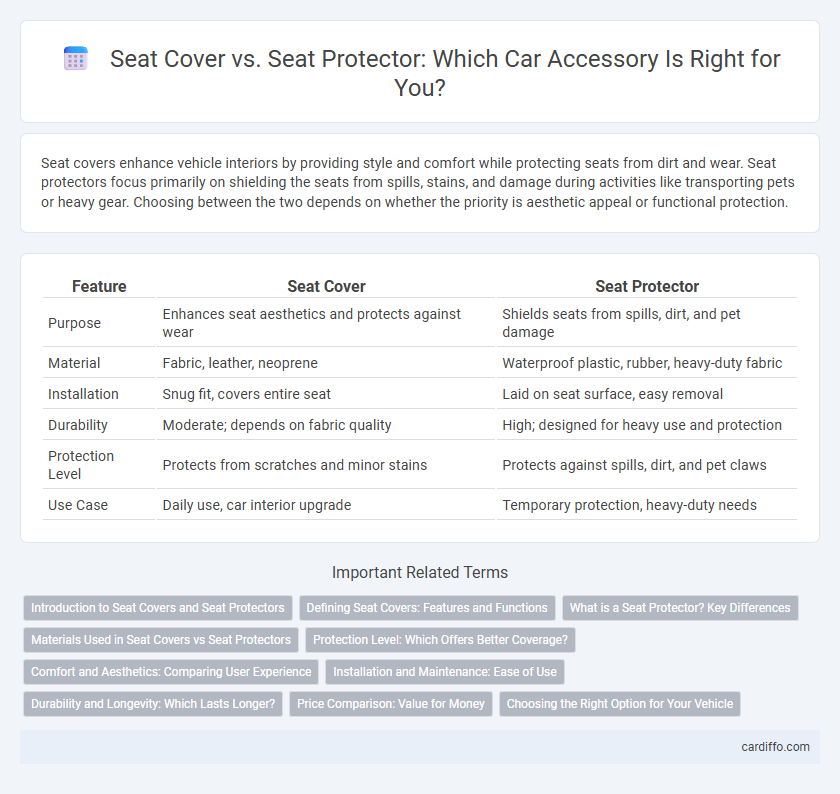Seat covers enhance vehicle interiors by providing style and comfort while protecting seats from dirt and wear. Seat protectors focus primarily on shielding the seats from spills, stains, and damage during activities like transporting pets or heavy gear. Choosing between the two depends on whether the priority is aesthetic appeal or functional protection.
Table of Comparison
| Feature | Seat Cover | Seat Protector |
|---|---|---|
| Purpose | Enhances seat aesthetics and protects against wear | Shields seats from spills, dirt, and pet damage |
| Material | Fabric, leather, neoprene | Waterproof plastic, rubber, heavy-duty fabric |
| Installation | Snug fit, covers entire seat | Laid on seat surface, easy removal |
| Durability | Moderate; depends on fabric quality | High; designed for heavy use and protection |
| Protection Level | Protects from scratches and minor stains | Protects against spills, dirt, and pet claws |
| Use Case | Daily use, car interior upgrade | Temporary protection, heavy-duty needs |
Introduction to Seat Covers and Seat Protectors
Seat covers enhance vehicle interiors by providing style and personalized comfort while protecting upholstery from wear and stains. Seat protectors prioritize safeguarding seats from spills, dirt, and damage, especially in high-traffic or pet-friendly vehicles. Both accessories are essential for maintaining car seat longevity and preserving resale value.
Defining Seat Covers: Features and Functions
Seat covers are designed as custom-fit or universal fabric materials that fully envelop vehicle seats, offering protection against spills, stains, UV damage, and wear while enhancing interior aesthetics. They often feature materials like neoprene, leather, or polyester with padding for comfort and can include waterproof layers, anti-slip backing, and easy installation mechanisms such as elastic straps or Velcro. Unlike seat protectors, which primarily shield against dirt and moisture from boots or pets, seat covers provide comprehensive coverage to maintain seat condition and add style.
What is a Seat Protector? Key Differences
A seat protector is a specialized accessory designed to shield car seats from dirt, spills, and wear, often made from waterproof and durable materials for heavy-duty protection. Unlike seat covers that primarily enhance aesthetics and comfort, seat protectors focus on preserving the seat's condition, especially useful for pet owners or transporting messy items. Key differences include the seat protector's emphasis on safeguarding against damage and spills, whereas seat covers provide style and cushioning to the vehicle interior.
Materials Used in Seat Covers vs Seat Protectors
Seat covers are typically made from durable materials such as leather, neoprene, polyester, or faux suede, designed to enhance comfort and style while providing moderate protection. In contrast, seat protectors often utilize heavy-duty, waterproof fabrics like PVC, nylon, or rubberized materials intended to shield seats from spills, dirt, and wear during activities such as transporting pets or outdoor gear. The difference in materials reflects their primary functions: seat covers balance aesthetics and comfort, whereas seat protectors prioritize durability and resistance to damage.
Protection Level: Which Offers Better Coverage?
Seat covers provide comprehensive protection by fully encasing the seat, shielding against spills, dirt, UV rays, and wear from regular use. Seat protectors generally offer partial coverage, targeting specific vulnerable areas to guard against stains and damage but leaving exposed sections more susceptible. Choosing seat covers ensures maximum coverage and preservation of the seat's original condition, ideal for heavy use or long-term protection.
Comfort and Aesthetics: Comparing User Experience
Seat covers enhance vehicle interiors by offering customized comfort with padded materials and stylish designs that complement car aesthetics. Seat protectors prioritize durability and functionality, shielding upholstery from spills and wear while often featuring simpler, less visually appealing designs. Users seeking a blend of comfort and visual appeal typically prefer seat covers, whereas those emphasizing practical protection opt for seat protectors.
Installation and Maintenance: Ease of Use
Seat covers typically offer easier installation with adjustable straps and elastic bands that fit a variety of seat sizes, making them user-friendly for quick setup. Seat protectors, designed mainly for safeguarding the seat from spills and damage, often feature simple non-slip backing for effortless placement and removal. Maintenance for seat covers usually involves machine washing or spot cleaning, while seat protectors require minimal upkeep with just a wipe-down using a damp cloth.
Durability and Longevity: Which Lasts Longer?
Seat protectors are typically made from heavy-duty materials like rubber or thick vinyl, offering superior durability against spills, dirt, and wear compared to seat covers, which often use fabric or leather that can wear out faster. Seat covers provide comfort and style but may require more frequent replacement due to fading, tearing, or staining. For long-term protection and durability, seat protectors generally last longer and maintain vehicle interior quality more effectively.
Price Comparison: Value for Money
Seat covers generally offer more style options and comfort features at a moderate price, whereas seat protectors prioritize durability and easy maintenance with a lower cost. Investing in seat covers usually provides enhanced aesthetic appeal and customization, making them a better value for users seeking interior upgrades. Seat protectors deliver essential protection against spills and wear, ideal for high-usage environments where budget constraints prioritize function over form.
Choosing the Right Option for Your Vehicle
Selecting the right accessory for your vehicle depends on the balance between style and functionality; seat covers enhance interior aesthetics while offering moderate protection, whereas seat protectors are designed primarily to shield from spills, dirt, and wear without altering the seat's appearance. Materials like neoprene and leatherette provide durability and easy maintenance for seat covers, while heavy-duty rubber or waterproof fabrics dominate protective options for harsh conditions. Understanding your vehicle usage, climate, and preference for customization ensures you choose between a seat cover that upgrades your cabin or a seat protector that maintains its original condition.
Seat cover vs Seat protector Infographic

 cardiffo.com
cardiffo.com